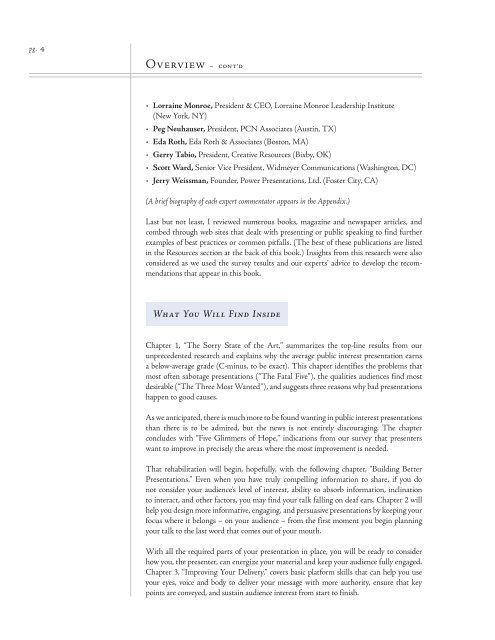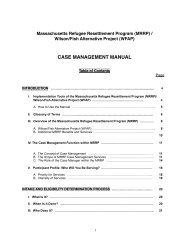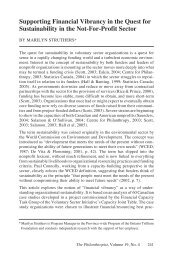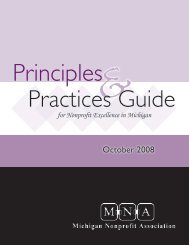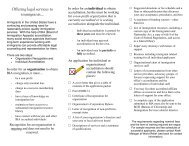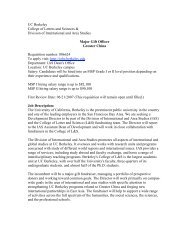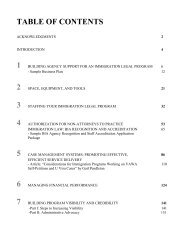Why Bad Presentations Happen to Good Causes - The Goodman ...
Why Bad Presentations Happen to Good Causes - The Goodman ...
Why Bad Presentations Happen to Good Causes - The Goodman ...
You also want an ePaper? Increase the reach of your titles
YUMPU automatically turns print PDFs into web optimized ePapers that Google loves.
pg. 4<br />
Overview – cont’d<br />
• Lorraine Monroe, President & CEO, Lorraine Monroe Leadership Institute<br />
(New York, NY)<br />
• Peg Neuhauser, President, PCN Associates (Austin, TX)<br />
• Eda Roth, Eda Roth & Associates (Bos<strong>to</strong>n, MA)<br />
• Gerry Tabio, President, Creative Resources (Bixby, OK)<br />
• Scott Ward, Senior Vice President, Widmeyer Communications (Washing<strong>to</strong>n, DC)<br />
• Jerry Weissman, Founder, Power <strong>Presentations</strong>, Ltd. (Foster City, CA)<br />
(A brief biography of each expert commenta<strong>to</strong>r appears in the Appendix.)<br />
Last but not least, I reviewed numerous books, magazine and newspaper articles, and<br />
combed through web sites that dealt with presenting or public speaking <strong>to</strong> find further<br />
examples of best practices or common pitfalls. (<strong>The</strong> best of these publications are listed<br />
in the Resources section at the back of this book.) Insights from this research were also<br />
considered as we used the survey results and our experts’ advice <strong>to</strong> develop the recommendations<br />
that appear in this book.<br />
What You Will Find Inside<br />
Chapter 1, “<strong>The</strong> Sorry State of the Art,” summarizes the <strong>to</strong>p-line results from our<br />
unprecedented research and explains why the average public interest presentation earns<br />
a below-average grade (C-minus, <strong>to</strong> be exact). This chapter identifies the problems that<br />
most often sabotage presentations (“<strong>The</strong> Fatal Five”), the qualities audiences find most<br />
desirable (“<strong>The</strong> Three Most Wanted”), and suggests three reasons why bad presentations<br />
happen <strong>to</strong> good causes.<br />
As we anticipated, there is much more <strong>to</strong> be found wanting in public interest presentations<br />
than there is <strong>to</strong> be admired, but the news is not entirely discouraging. <strong>The</strong> chapter<br />
concludes with “Five Glimmers of Hope,” indications from our survey that presenters<br />
want <strong>to</strong> improve in precisely the areas where the most improvement is needed.<br />
That rehabilitation will begin, hopefully, with the following chapter, “Building Better<br />
<strong>Presentations</strong>.” Even when you have truly compelling information <strong>to</strong> share, if you do<br />
not consider your audience’s level of interest, ability <strong>to</strong> absorb information, inclination<br />
<strong>to</strong> interact, and other fac<strong>to</strong>rs, you may find your talk falling on deaf ears. Chapter 2 will<br />
help you design more informative, engaging, and persuasive presentations by keeping your<br />
focus where it belongs – on your audience – from the first moment you begin planning<br />
your talk <strong>to</strong> the last word that comes out of your mouth.<br />
With all the required parts of your presentation in place, you will be ready <strong>to</strong> consider<br />
how you, the presenter, can energize your material and keep your audience fully engaged.<br />
Chapter 3, “Improving Your Delivery,” covers basic platform skills that can help you use<br />
your eyes, voice and body <strong>to</strong> deliver your message with more authority, ensure that key<br />
points are conveyed, and sustain audience interest from start <strong>to</strong> finish.


